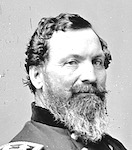 Open main menu
Open main menu
 Open main menu
Open main menu

J. Sedgwick
"Uncle John"
(1813 - 1864)
Home State: Connecticut
Education: US Military Academy, West Point, NY, Class of 1837;Class Rank: 24
Command Billet: Commanding Division
Branch of Service: Infantry
Unit: 2nd Division, 2nd Corps
Before Antietam
After West Point, he was assigned to the artillery, he fought in the Seminole War, was involved in the Trail of Tears episode, and earned two brevets in the Mexican War. In 1855 he transferred to the Cavalry, and served in "Bleeding Kansas," on the Mormon Expedition, and in Indian fighting in the West.
At the outbreak of the Civil War he was Major, 1st US Cavalry. He was promoted to Lieutenant Colonel, 2nd US on 16 March 1861, and Colonel of the 1st US Cavalry on 25 April. He was appointed Brigadier General (USV) 31 August 1861, and Major General 4 July 1862. He was slightly wounded in action at Glendale, VA on 30 June 1862.
On the Campaign
He commanded the Second Division of General Sumner's Second Army Corps in a disastrous assault on Confederates in the West Woods at Antietam on 17 September 1862. He was seriously wounded 3 times, in the leg, wrist, and shoulder early in the action there. General McClellan later reported:
General Sedgwick, though twice [sic] wounded and faint from loss of blood, retained command of his division for more than an hour after his first wound, animating his command by his presence ... General Howard assumed command after General Sedgwick retired.
The rest of the War
He was out of action recovering from his wounds until 22 December 1862. On the Rappahannock Campaign he commanded the 9th Corps, and then, from 5 February 1863, the 6th Corps. He commanded the troops who stormed Marye Heights on 3 May 3, 1863, and his Corps on the Gettysburg (June-July 1863) and the Rapidan Campaigns (September-November). He commanded the right wing (5th and 6th Corps) of the Army of the Potomac at Rappahannock Station (7 November) and at Mine Run (26 November-3 December). He was again in command of the 6th Corps in May 1864 and was engaged in the Wilderness on 5 and 6 May. He was killed by a Confederate sharpshooter at Spotsylvania, VA on 9 May 1864 while personally positioning his Corps artillery. Reportedly he had just said that "they couldn't hit an elephant at this distance."
References & notes
His service from Heitman1 and Cullum (#914).2 Details from Martin T. McMahon (VI Corps Chief of Staff), The Death of General John Sedgwick, in Battles and Leaders of the Civil War (1888) and A Biographical Sketch; John Sedgwick, Major-General (1899) by his sister Emily Sedgwick Welch. His gravesite is on Findagrave. His picture from a photograph in the National Archives (via Flickr). Thanks to John A. Reeves for helping improve the General's post-Antietam service details.
Named for the General, Sedgwick County, Kansas with the county seat at Wichita, was established on 26 February 1867, and Sedgewick County, Colorado, was officially created in April 1889. A monument to his memory, cast from the guns taken in action by the VI Corps, was erected at West Point in 1868.
Birth
9/13/1813; Cornwall Hollow, CT
Death
5/9/1864; Spotsylvania Court House, VA; burial in Cornwall Hollow Cemetery, Cornwall Hollow, CT
1 Heitman, Francis Bernard, Historical Register and Dictionary of the United States Army 1789-1903, 2 volumes, Washington DC: US Government Printing Office, 1903, Vol. 1, pg. 872 [AotW citation 18701]
2 Cullum, George Washington, Biographical Register of the Officers and Graduates of the US Military Academy, 2nd Edition, 3 vols., New York: D. Van Nostrand, 1868-79, Vol. 1, pp. 680-683 [AotW citation 18702]